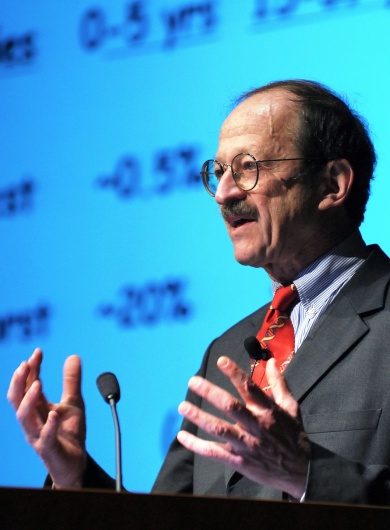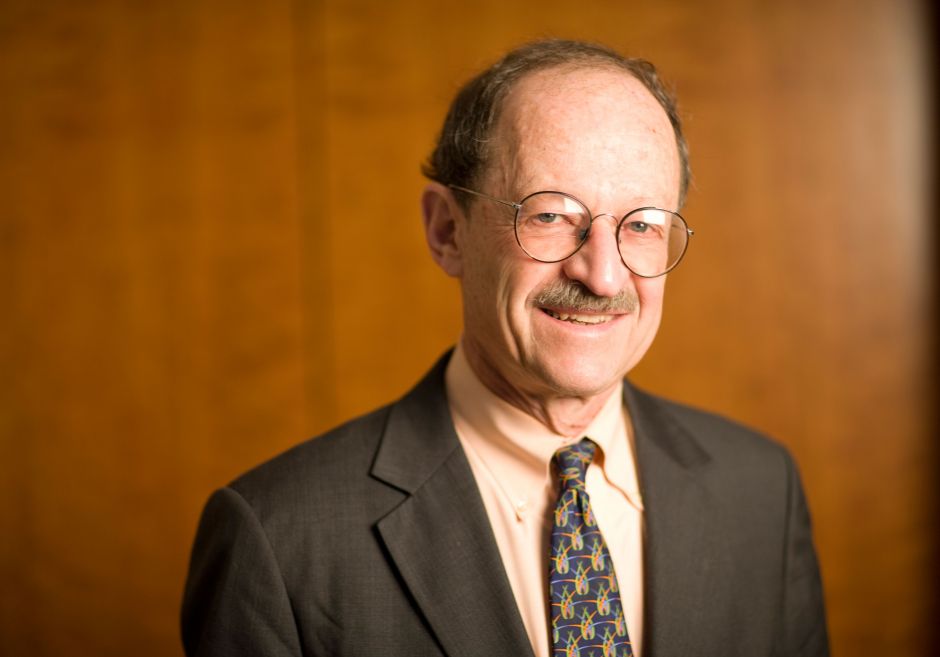Can cancer be stopped?
Just 12 days ago, I concluded a nearly five-year stint as director of the National Cancer Institute, and I have been engaged in basic research on cancer for almost 45 years. So I know it can be hard for those outside the research arena to judge how much progress we have made against afflictions that cost us so much in suffering, loss of life and medical expense, and that present such monumental challenges for medical science.
On the one hand, most of my colleagues — and I — are invigorated by the enormous amount we have learned about cancer's origins and about new strategies for preventing, diagnosing and treating the diseases we group under this name. Yet, understandably, cancer remains frightening to most people; it will ultimately afflict nearly half of U.S. inhabitants, causing over half a million deaths per year here and nearly 8 million worldwide.
How can we reconcile these two perspectives? Over the past several weeks, I have had numerous opportunities to try, thanks to two events that have attracted widespread attention: a three-part PBS documentary about cancer, based on Siddartha Mukherjee's prize-winning book, "The Emperor of All Maladies" and President Obama's announcement of a Precision Medicine Initiative, with a major focus on cancer research.
The questions I have been asked about these events reflect a wide range of knowledge and feelings about the state of cancer research and our ability to control cancers. Some people are enthused about recent progress, but others are critical or even sarcastic about the advances described by scientists and our proponents in the press.
In the exchange below, I pose and answer some questions that I am often asked — and some that I would like to be asked more often — hoping to offer balanced and informative responses to difficult problems.
Are we making real progress against cancer?
Most experts agree that the best single measure of the toll cancer takes, and how our efforts are changing that toll, is the age-adjusted cancer death rate. That number, determined every year, represents the number of deaths attributable to all forms of cancer in the U.S. after adjustment for population size and age.
The number has been declining by about 1% to 2% per year for well over a decade — a positive sign. Of course, the trends are more favorable for some types of cancers than for others, and not all of the gains are attributable to recent research or to better treatments. One single factor — a 50% decline in the percentage of tobacco users in this country since the 1960s — accounts for a large percentage of the improvement.
The decline could almost certainly be significantly faster, even without more research or improved cancer treatments, if more people followed current medical recommendations for prevention and early detection.
What is the "precision medicine" initiative that President Obama has recently asked Congress to fund?
The President is responding to new evidence that we can make better use of precise molecular information about diseases, especially cancers, to diagnose and control them more effectively.
If there is one big thing that research has taught us about cancer over the past couple of decades it is this: Complexity. Cancer is not one disease, it is many. Cancers arise from hundreds of different cell types in our bodies as a result of many kinds of changes in a cell's genome (the full set of genes in our chromosomes).
These genetic variations can affect hundreds, even thousands, of genes, making every cancer different, just as every snowflake is thought to be different. Fortunately, there are also commonalities that allow some cancers to be grouped together, as well as distinguished from others, and only a subset of the alterations seem to be functionally important.
Recently compiled catalogs of these genetic changes allow precise redefinitions of cancers, providing new diagnostic categories. No longer should cancers be labeled simply by the organs in which they arise (such as the lung) or by the type of cell that most closely resembles the cancer cells. Now they are also categorized by the kinds of genetic mutations found in the cancer cell's chromosomes.
More precise classification of cancers are already influencing the kind of therapies that are used and being developed. In addition, the genetic information is teaching us about the causes of cancers and is useful in thinking about prevention. This resembles what once happened with infectious diseases, when the specific microbes causing (for instance) pneumonias were identified, and powerful drugs and vaccines were then developed.
The President's initiative reflects his conviction that greater study of these features of cancer, and of the way they are applied in the control of cancer, will have great benefits in coming years. I agree with him. But to obtain full advantage, we will need to gather yet more information about cancers; assemble and learn from it; get the messages to oncologists, patients and others; and provide all cancer patients with appropriate access to the new diagnostic tools, especially as the costs continue to decline.
But how can you say that precision medicine is so beneficial and desirable, when death rates have changed so little?
Unfortunately, improved outcomes for a broad set of diseases, such as the various cancers, are likely to occur slowly. The situation is very different from what happens when an effective vaccine, like for polio, is introduced. An infectious disease is generally caused by an organism with common properties, so a vaccine can quickly protect virtually everyone from the disease.
Cancers are not like that. Each new drug or antibody that is designed to block precisely the actions of an abnormal gene usually have dramatic effects on only a small number of patients with a specific type of cancer. In the best case thus far, virtually all of the 6,000 American patients who develop chronic myeloid leukemia each year have the same kind of mutation, and they have a dramatic response to the same targeted drug, known as imatinib (sold as Gleevec). Most such patients can expect to live a normal lifespan. But they comprise less than 1% of all U.S. cancer patients.
But the problem goes deeper. As I've already mentioned, cancers in most traditional diagnostic groups (e.g. lung cancer) have different sets of mutations and require different therapies. Moreover, cancers continue to evolve genetically, each cell resembling an individual organism in a species, threatening to emerge as a different genetic subspecies.
Continued changes in their genomes render some tumor cells resistant to targeted drugs. Then the tumors regrow and spread in the presence of the drug unless a new therapy can be found. Sometimes that has been successful, but often not.
Figuring out why tumors become resistant to treatments and how to avoid or overcome resistance are among the problems the President's initiative aims to solve. They are not easy problems, but we've solved similar ones before — for instance, when combinations of drugs targeted against HIV were shown to overcome resistance to individual drugs.
Aren't these targeted drugs just one way to attack the cancer problem? Shouldn't we put more effort into other kinds of treatment?
Absolutely. First of all, developing new kinds of drugs does not preclude the use of treatments that have worked well for many years — especially surgery for localized cancers, radiotherapy for radiation-sensitive tumors, and chemotherapy for some curable or controllable diseases.
Second, it is crucial to remember the enormous deficiencies in our knowledge: We still don't fully understand how distorted genes produce the bad behaviors of cancer cells or how cancer cells interact with other cells in the vicinity, such as blood vessel cells or cells from the immune system.
The promise of greater knowledge is well-documented: For instance, based on decades of fundamental studies of immunity, several kinds of immunotherapies are now producing dramatic and often sustained remissions of certain kinds of cancers. These treatments too will soon be guided by genetic assessments and become part of precision medicine.
Finally, we should not forget the importance of the methods we use to control the symptoms of cancers — especially pain, depression, and weight loss — and the toxic effects of some therapies, such as bone marrow suppression and infection.
Isn't genetic damage just one kind of explanation for cancer? Why don't you pay more attention to the factors, like environmental pollutants, tobacco and foods, that actually cause cancers?
The recognition that cancers arise from genetic damage has allowed a synthesis of ideas: the environmental factors that we think of as causes of cancer, such as tobacco smoke and ultraviolet light, are the agents that damage genes. We can now recognize the factors responsible for individual cancers because they leave behind a mutational "signature" that can help identify the major causes of cancerous genetic damage. These identifications should increasingly guide efforts to prevent cancer.
Do you think we can ever eliminate cancers entirely?
This seems implausible, given that many of the cancer-driving mutations arise from error-prone mechanisms that can damage our chromosomes when genomes are duplicated during normal cell division.
But I also believe that we can significantly lower cancer incidence and death rates now — by reducing the behaviors (such as smoking, bad diet, alcohol use, inactivity, and excessive exposure to sunlight) that heighten cancer risk; by using available vaccines against cancer-causing viruses (such as hepatitis B and papilloma viruses); and by taking precautionary measures to protect individuals who inherit the several known gene variants that confer significantly increased risks of cancer.
We can also reduce cancer deaths now by wider use of effective methods to detect cancers at early stages, especially skin, colorectal and breast cancers.
Finally, I think we can turn most if not all cancers into chronic, controllable, non-lethal disorders, and sometimes cure them, even after they have widely metastasized, if we make the necessary investments in development and testing of new therapies.
What is needed for cancer research to move faster?
Money is essential for research of any kind. The major funder of most cancer research in this country, apart from development of new treatments by industry, is the federal government, through appropriations to the National Institutes of Health. In the past dozen years, as a result of sub-inflationary increases in Congressional appropriations, and even some decreases, the NIH has lost about 25% of its buying power. Over the past five years, the budget has even fallen in real dollars. Shockingly, the NCI has $177 million less to spend now than it did in 2010.
These circumstances, combined with enormous scientific opportunities, should make reversal of the fiscal trends easy to justify, but that reversal has yet to occur.
Still, money is not everything. Progress against disease also requires talent and new ideas. These cannot be bought directly. They depend on recruitment of smart young people — from our own country and abroad — and on building research environments in which investigators feel free to pursue unconventional ideas, invent new technologies, and learn from failure as well as success. In the current hypercompetitive atmosphere of medical research, those freedoms are less available than they once were.
A re-engineering of the research enterprise, as well as some restoration of funds, will be required to re-establish a climate in which research can flourish. But that is another story.
This article first appeared in the New York Daily News.




